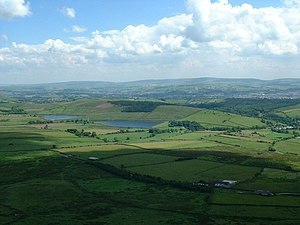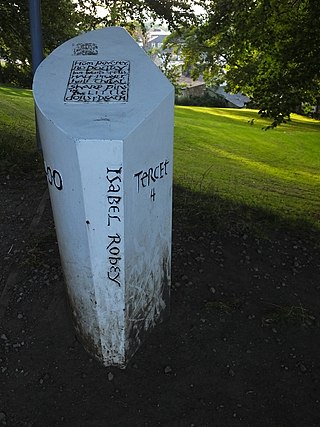
Higham is a village in the Borough of Pendle in Lancashire, England, south of Pendle Hill. The civil parish is named Higham with West Close Booth. The village is 2 miles (3 km) north-east of Padiham and about 4 miles (6 km) south-west of Nelson along the A6068 road.

Pendle Hill is in the east of Lancashire, England, near the towns of Burnley, Nelson, Colne, Brierfield, Clitheroe and Padiham. Its summit is 557 metres (1,827 ft) above mean sea level. It gives its name to the Borough of Pendle. It is an isolated hill in the Pennines, separated from the South Pennines to the east, the Bowland Fells to the northwest, and the West Pennine Moors to the south. It is included in a detached part of the Forest of Bowland Area of Outstanding Natural Beauty.
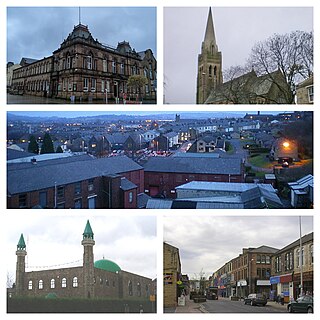
Nelson is a town and civil parish in the Borough of Pendle in Lancashire, England, with a population of 29,135 in 2011. It is 4 miles (6.4 km) north of Burnley and 3 miles south-west of Colne.
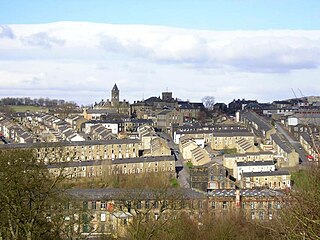
Colne is a market town and civil parish in the Borough of Pendle in Lancashire, England. Located three miles northeast of Nelson, six miles northeast of Burnley, 25 mi (40 km) east of Preston and 30 mi (50 km) west of Leeds.

Blacko is a village and civil parish in the Pendle district of Lancashire, England. Before local government reorganisation in 1974 the village lay on the border with the West Riding of Yorkshire. The parish has a population of 672. The village is on the old turnpike road from Nelson to Gisburn (A682). The village enjoys views towards Boulsworth Hill to its southeast, the former cotton town of Nelson, about two miles to its south and Pendle Hill to its west across the valley of Pendle Water.

Samlesbury is a village and civil parish in South Ribble, Lancashire, England. Samlesbury Hall, a historic house, is in the village, as is Samlesbury Aerodrome and a large modern brewery owned by Anheuser-Busch InBev. The population at the 2011 census was 1,206.
The Late Lancashire Witches is a Caroline-era stage play and written by Thomas Heywood and Richard Brome, published in 1634. The play is a topical melodrama on the subject of the witchcraft controversy that arose in Lancashire in 1633.

Newchurch in Pendle is a village in the civil parish of Goldshaw Booth, Pendle, Lancashire, England, adjacent to Barley, to the south of Pendle Hill. It was formerly part of Roughlee Booth until its transferral in 1935.

Alice Nutter was an English woman accused and hanged as a result of the Pendle witch hunt. Her life and death are commemorated by a statue in the village of Roughlee in the Pendle district of Lancashire.

The Northamptonshire witch trials mainly refer to five executions carried out on 22 July 1612 at Abington Gallows, Northampton. In 1612 at the Lent Assizes held in Northampton Castle a number of women and a man were tried for witchcraft of various kinds, from murder to bewitching of pigs. There are two main accounts of these witches being tried. However they differ on how many witches were tried, who they were and exactly what they were supposed to have done.

The trials of the Pendle witches in 1612 are among the most famous witch trials in English history, and some of the best recorded of the 17th century. The twelve accused lived in the area surrounding Pendle Hill in Lancashire, and were charged with the murders of ten people by the use of witchcraft. All but two were tried at Lancaster Assizes on 18–19 August 1612, along with the Samlesbury witches and others, in a series of trials that have become known as the Lancashire witch trials. One was tried at York Assizes on 27 July 1612, and another died in prison. Of the eleven who went to trial – nine women and two men – ten were found guilty and executed by hanging; one was found not guilty.
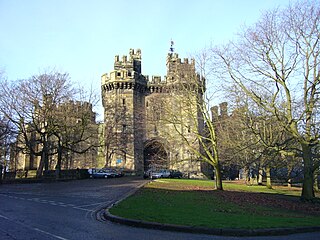
The Samlesbury witches were three women from the Lancashire village of Samlesbury – Jane Southworth, Jennet Bierley, and Ellen Bierley – accused by a 14-year-old girl, Grace Sowerbutts, of practising witchcraft. Their trial at Lancaster Assizes in England on 19 August 1612 was one in a series of witch trials held there over two days, among the most infamous in English history. The trials were unusual for England at that time in two respects: Thomas Potts, the clerk to the court, published the proceedings in his The Wonderfull Discoverie of Witches in the Countie of Lancaster; and the number of the accused found guilty and hanged was unusually high, ten at Lancaster and another at York. All three of the Samlesbury women were acquitted.

The Wonderfull Discoverie of Witches in the Countie of Lancaster is the account of a series of English witch trials that took place on 18–19 August 1612, commonly known as the Lancashire witch trials. Except for one trial held in York they took place at Lancaster Assizes. Of the twenty men and women accused – amongst them the Pendle witches and the Samlesbury witches – eleven were found guilty and subsequently hanged; one was sentenced to stand in the pillory, and the rest were acquitted.
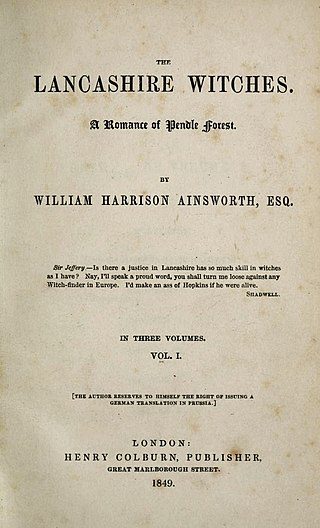
The Lancashire Witches is the only one of William Harrison Ainsworth's forty novels that has remained continuously in print since its first publication. It was serialised in the Sunday Times newspaper in 1848; a book edition appeared the following year, published by Henry Colburn. The novel is based on the true story of the Pendle witches, who were executed in 1612 for causing harm by witchcraft. Modern critics such as David Punter consider the book to be Ainsworth's best work. E. F. Bleiler rated the novel as "one of the major English novels about witchcraft".

St Bartholomew's Church is in the town of Colne in Lancashire, England. It is an active Anglican parish church in the Diocese of Blackburn. There has been a church on the site since no later than the 12th century although the present building mostly dates from the 16th century. It is recorded in the National Heritage List for England as a designated Grade I listed building.
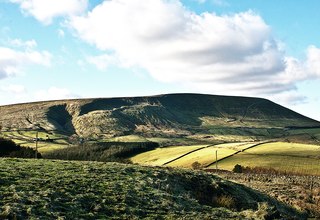
Pendle is a local government district with borough status in Lancashire, England. The council is based in Nelson, the borough's largest town. The borough also includes the towns of Barnoldswick, Brierfield, Colne and Earby along with the surrounding villages and rural areas. Part of the borough lies within the Forest of Bowland Area of Outstanding Natural Beauty.
Margaret Pearson, also known as the Padiham witch because she lived in the town of Padiham in Lancashire, England, was among those tried with the Pendle witches in the Lancashire witch trials of 1612. This, her third trial for witchcraft, took place on 19 August at Lancaster Assizes in front of Sir James Altham and Sir Edward Bromley.
Thomas Potts was an English law clerk, and the author of the Discoverie of Witches.
